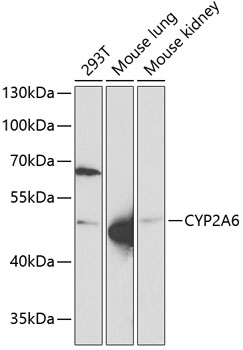Cell Biology Antibodies 9
Anti-CYP2A6 Antibody (CAB5815)
- SKU:
- CAB5815
- Product Type:
- Antibody
- Reactivity:
- Human
- Reactivity:
- Mouse
- Host Species:
- Rabbit
- Isotype:
- IgG
- Antibody Type:
- Polyclonal Antibody
- Research Area:
- Cell Biology
Description
| Antibody Name: | Anti-CYP2A6 Antibody |
| Antibody SKU: | CAB5815 |
| Antibody Size: | 20uL, 50uL, 100uL |
| Application: | WB |
| Reactivity: | Human, Mouse |
| Host Species: | Rabbit |
| Immunogen: | Recombinant fusion protein containing a sequence corresponding to amino acids 215-494 of human CYP2A6 (NP_000753.3). |
| Application: | WB |
| Recommended Dilution: | WB 1:500 - 1:2000 |
| Reactivity: | Human, Mouse |
| Positive Samples: | 293T, Mouse lung, Mouse kidney |
| Immunogen: | Recombinant fusion protein containing a sequence corresponding to amino acids 215-494 of human CYP2A6 (NP_000753.3). |
| Purification Method: | Affinity purification |
| Storage Buffer: | Store at -20'C. Avoid freeze / thaw cycles. Buffer: PBS with 0.02% sodium azide, 50% glycerol, pH7.3. |
| Isotype: | IgG |
| Sequence: | STGQ LYEM FSSV MKHL PGPQ QQAF QLLQ GLED FIAK KVEH NQRT LDPN SPRD FIDS FLIR MQEE EKNP NTEF YLKN LVMT TLNL FIGG TETV STTL RYGF LLLM KHPE VEAK VHEE IDRV IGKN RQPK FEDR AKMP YMEA VIHE IQRF GDVI PMSL ARRV KKDT KFRD FFLP KGTE VYPM LGSV LRDP SFFS NPQD FNPQ HFLN EKGQ FKKS DAFV PFSI GKRN CFGE GLAR MELF LFFT TVMQ NFRL KSSQ SPKD IDVS PKHV GFAT IPRN YTMS FLPR |
| Gene ID: | 1548 |
| Uniprot: | P11509 |
| Cellular Location: | Endoplasmic reticulum membrane, Microsome membrane, Peripheral membrane protein |
| Calculated MW: | 56kDa |
| Observed MW: | 50kDa |
| Synonyms: | CYP2A6, CPA6, CYP2A, CYP2A3, CYPIIA6, P450C2A, P450PB |
| Background: | This gene, CYP2A6, encodes a member of the cytochrome P450 superfamily of enzymes. The cytochrome P450 proteins are monooxygenases which catalyze many reactions involved in drug metabolism and synthesis of cholesterol, steroids and other lipids. This protein localizes to the endoplasmic reticulum and its expression is induced by phenobarbital. The enzyme is known to hydroxylate coumarin, and also metabolizes nicotine, aflatoxin B1, nitrosamines, and some pharmaceuticals. Individuals with certain allelic variants are said to have a poor metabolizer phenotype, meaning they do not efficiently metabolize coumarin or nicotine. This gene is part of a large cluster of cytochrome P450 genes from the CYP2A, CYP2B and CYP2F subfamilies on chromosome 19q. The gene was formerly referred to as CYP2A3; however, it has been renamed CYP2A6. |
| UniProt Protein Function: | CYP2A6: Exhibits a high coumarin 7-hydroxylase activity. Can act in the hydroxylation of the anti-cancer drugs cyclophosphamide and ifosphamide. Competent in the metabolic activation of aflatoxin B1. Constitutes the major nicotine C-oxidase. Acts as a 1,4- cineole 2-exo-monooxygenase. Possesses low phenacetin O- deethylation activity. Belongs to the cytochrome P450 family. |
| UniProt Protein Details: | Protein type:Endoplasmic reticulum; EC 1.14.14.1; Cofactor and Vitamin Metabolism - retinol; Xenobiotic Metabolism - drug metabolism - other enzymes; Xenobiotic Metabolism - drug metabolism - cytochrome P450; Oxidoreductase; Secondary Metabolites Metabolism - caffeine Chromosomal Location of Human Ortholog: 19q13.2 Cellular Component: endoplasmic reticulum membrane; intracellular membrane-bound organelle; cytoplasmic microtubule Molecular Function:coumarin 7-hydroxylase activity; enzyme binding; iron ion binding; oxidoreductase activity, acting on paired donors, with incorporation or reduction of molecular oxygen, reduced flavin or flavoprotein as one donor, and incorporation of one atom of oxygen; heme binding; arachidonic acid epoxygenase activity; steroid hydroxylase activity; oxygen binding Biological Process: steroid metabolic process; coumarin metabolic process; xenobiotic metabolic process; coumarin catabolic process; exogenous drug catabolic process; epoxygenase P450 pathway; drug metabolic process Disease: Tobacco Addiction, Susceptibility To; Lung Cancer; Coumarin Resistance |
| NCBI Summary: | This gene, CYP2A6, encodes a member of the cytochrome P450 superfamily of enzymes. The cytochrome P450 proteins are monooxygenases which catalyze many reactions involved in drug metabolism and synthesis of cholesterol, steroids and other lipids. This protein localizes to the endoplasmic reticulum and its expression is induced by phenobarbital. The enzyme is known to hydroxylate coumarin, and also metabolizes nicotine, aflatoxin B1, nitrosamines, and some pharmaceuticals. Individuals with certain allelic variants are said to have a poor metabolizer phenotype, meaning they do not efficiently metabolize coumarin or nicotine. This gene is part of a large cluster of cytochrome P450 genes from the CYP2A, CYP2B and CYP2F subfamilies on chromosome 19q. The gene was formerly referred to as CYP2A3; however, it has been renamed CYP2A6. [provided by RefSeq, Jul 2008] |
| UniProt Code: | P11509 |
| NCBI GenInfo Identifier: | 308153612 |
| NCBI Gene ID: | 1548 |
| NCBI Accession: | P11509.3 |
| UniProt Secondary Accession: | P11509,P00190, P10890, Q16803, Q4VAT9, Q4VAU0, Q4VAU1 Q9H1Z7, Q9UCU0, Q9UK48, A7YAE5, B2R7F6, |
| UniProt Related Accession: | P11509 |
| Molecular Weight: | 494 |
| NCBI Full Name: | Cytochrome P450 2A6 |
| NCBI Synonym Full Names: | cytochrome P450, family 2, subfamily A, polypeptide 6 |
| NCBI Official Symbol: | CYP2A6 |
| NCBI Official Synonym Symbols: | CPA6; CYP2A; CYP2A3; P450PB; CYPIIA6; P450C2A |
| NCBI Protein Information: | cytochrome P450 2A6; cytochrome P450(I); cytochrome P450 IIA3; coumarin 7-hydroxylase; xenobiotic monooxygenase; 1,4-cineole 2-exo-monooxygenase; flavoprotein-linked monooxygenase; cytochrome P450, subfamily IIA (phenobarbital-inducible), polypeptide 6 |
| UniProt Protein Name: | Cytochrome P450 2A6 |
| UniProt Synonym Protein Names: | 1,4-cineole 2-exo-monooxygenase; CYPIIA6; Coumarin 7-hydroxylase; Cytochrome P450 IIA3; Cytochrome P450(I) |
| Protein Family: | Cytochrome |
| UniProt Gene Name: | CYP2A6 |
| UniProt Entry Name: | CP2A6_HUMAN |







